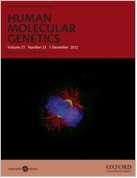JAMA:干细胞修复心脏受损组织
2013-05-06 Beyond 生物谷
近日,一项最新研究证实利用干细胞可修复受损的心脏。研究显示,异体捐赠的干细胞被证明是安全和有效的,可以用来帮助受捐助者修复心脏组织。 该研究涉及迈阿密和巴尔的摩地区的30例病例,相关研究发表在Journal of the American Medical Association杂志上。 本研究采用来自骨髓的特定类型干细胞,研究人员相信这种类型的干细胞不
近日,一项最新研究证实利用干细胞可修复受损的心脏。研究显示,异体捐赠的干细胞被证明是安全和有效的,可以用来帮助受捐助者修复心脏组织。
该研究涉及迈阿密和巴尔的摩地区的30例病例,相关研究发表在Journal of the American Medical Association杂志上。

本研究采用来自骨髓的特定类型干细胞,研究人员相信这种类型的干细胞不会被捐助者所排斥。迈阿密大学Joshua Hare博士解释说,与其他细胞不同的是,干细胞往往会被免疫系统当作为外部入侵物质。在本研究中,所涉及到的患者罹患了心脏病,有的甚至长达30年。所有患者均出现心脏衰竭,他们的心脏变得大而松弛,不能有效地泵出血液。
在巴尔的摩的约翰·霍普金斯大学的实验室中,研究人员用针从骨髓中获得细胞,然后将其在体外扩增培养了约一个月。然后,细胞通过腹股沟动脉管推送到心脏附近的疤痕组织部位,15例患者接受自己骨髓中的干细胞,15名患者接受来自陌生人的干细胞。大约一年后,两组患者的瘢痕组织均已经减少了约三分之一。患者的生活质量也得到大大改善。有一个指标来衡量心脏的泵血功能,结果两组患者之间并没有显著差异。现在医生们希望这些患者能随着时间的推移,病情将继续得到改善。
与干细胞相关的拓展阅读:
- Oncogenesis:揭示维生素A降低前列腺癌干细胞侵袭性机制
- JOT:骨髓干细胞移植对滥用酒精大鼠模型骨折愈合的影响
- Clin Cancer Res. :在HER2阴性乳腺癌中鉴定出HER2阳性干细胞
- Acta Biomater:新型干细胞装载运输技术可帮助眼睛受损者重获光明
- PLoS ONE:成功将成人胰腺干细胞转化为胰岛素产生细胞
- JAMA:干细胞修复心脏受损组织
- Hum Mol Genet:开发出治疗盲眼病的新型干细胞模型
- Circulation:干细胞因子微粒或可预防婴儿肺部疾病
- EMBO:放疗或衰老阻断神经干细胞产生神经元机制
- Nature Neuroscience :蛋白FIP200在神经干细胞维持和分化中起关键作用
- eLife:短期压力促进大脑神经干细胞产生更多的神经元机制
- Cell:胶质瘤干细胞可能支持血管功能和肿瘤生长
- Nature Communications:前列腺癌干细胞发生DNA重排导致癌症复发
- JBC:miR-155对间充质干细胞的免疫调节功能发挥重要调节作用
- GUT:羊水干细胞可修复肠道损害 更多信息请点击:有关干细胞更多资讯

doi:10.1001/jama.2012.25321
PMC:
PMID:
Comparison of Allogeneic vs Autologous Bone Marrow–Derived Mesenchymal Stem Cells Delivered by Transendocardial Injection in Patients With Ischemic Cardiomyopathy
Joshua M. Hare, MD; Joel E. Fishman, MD, PhD; Gary Gerstenblith, MD; Darcy L. DiFede Velazquez, RN, BSN; Juan P. Zambrano, MD; Viky Y. Suncion, MD; Melissa Tracy, MD; Eduard Ghersin, MD; Peter V. Johnston, MD; Jeffrey A. Brinker, MD; Elayne Breton, BSN, RN; Janice Davis-Sproul, MAS; Ivonne H. Schulman, MD; John Byrnes, MD; Adam M. Mendizabal, MS; Maureen H. Lowery, MD; Didier Rouy, MD, PhD; Peter Altman, PhD; Cheryl Wong Po Foo, PhD; Phillip Ruiz, MD; Alexandra Amador, BSMT; Jose Da Silva, PhD; Ian K. McNiece, PhD; Alan W. Heldman, MD
Context Mesenchymal stem cells (MSCs) are under evaluation as a therapy for ischemic cardiomyopathy (ICM). Both autologous and allogeneic MSC therapies are possible; however, their safety and efficacy have not been compared.
Objective To test whether allogeneic MSCs are as safe and effective as autologous MSCs in patients with left ventricular (LV) dysfunction due to ICM.
Design, Setting, and Patients A phase 1/2 randomized comparison (POSEIDON study) in a US tertiary-care referral hospital of allogeneic and autologous MSCs in 30 patients with LV dysfunction due to ICM between April 2, 2010, and September 14, 2011, with 13-month follow-up.
Intervention Twenty million, 100 million, or 200 million cells (5 patients in each cell type per dose level) were delivered by transendocardial stem cell injection into 10 LV sites.
Main Outcome Measures Thirty-day postcatheterization incidence of predefined treatment-emergent serious adverse events (SAEs). Efficacy assessments included 6-minute walk test, exercise peak VO2, Minnesota Living with Heart Failure Questionnaire (MLHFQ), New York Heart Association class, LV volumes, ejection fraction (EF), early enhancement defect (EED; infarct size), and sphericity index.
Results Within 30 days, 1 patient in each group (treatment-emergent SAE rate, 6.7%) was hospitalized for heart failure, less than the prespecified stopping event rate of 25%. The 1-year incidence of SAEs was 33.3% (n = 5) in the allogeneic group and 53.3% (n = 8) in the autologous group (P = .46). At 1 year, there were no ventricular arrhythmia SAEs observed among allogeneic recipients compared with 4 patients (26.7%) in the autologous group (P = .10). Relative to baseline, autologous but not allogeneic MSC therapy was associated with an improvement in the 6-minute walk test and the MLHFQ score, but neither improved exercise VO2 max. Allogeneic and autologous MSCs reduced mean EED by ?33.21% (95% CI, ?43.61% to ?22.81%; P < .001) and sphericity index but did not increase EF. Allogeneic MSCs reduced LV end-diastolic volumes. Low-dose concentration MSCs (20 million cells) produced greatest reductions in LV volumes and increased EF. Allogeneic MSCs did not stimulate significant donor-specific alloimmune reactions.
Conclusions In this early-stage study of patients with ICM, transendocardial injection of allogeneic and autologous MSCs without a placebo control were both associated with low rates of treatment-emergent SAEs, including immunologic reactions. In aggregate, MSC injection favorably affected patient functional capacity, quality of life, and ventricular remodeling.
本网站所有内容来源注明为“梅斯医学”或“MedSci原创”的文字、图片和音视频资料,版权均属于梅斯医学所有。非经授权,任何媒体、网站或个人不得转载,授权转载时须注明来源为“梅斯医学”。其它来源的文章系转载文章,或“梅斯号”自媒体发布的文章,仅系出于传递更多信息之目的,本站仅负责审核内容合规,其内容不代表本站立场,本站不负责内容的准确性和版权。如果存在侵权、或不希望被转载的媒体或个人可与我们联系,我们将立即进行删除处理。
在此留言










